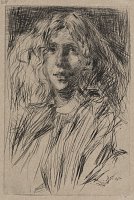Jo | ||
| Number: | 87 | |
| Date: | 1861 | |
| Medium: | drypoint | |
| Size: | 227 x 152 mm | |
| Signed: | 'Whistler.' at lower right | |
| Inscribed: | '1861.' at lower right | |
| Set/Publication: | 'Cancelled Plates', 1879 | |
| No. of States: | 1 | |
| Known impressions: | 25 | |
| Catalogues: | K.77; M.77; T.60; W.64 | |
| Impressions taken from this plate (25) | ||
PUBLICATION
It was published in an album of Cancelled Plates ('Cancelled Set') by The Fine Art Society, London, 1879 (, ).
EXHIBITIONS
It was first exhibited with the collection of James Anderson Rose (1819-1890) in a travelling show in Liverpool and elsewhere in 1874 as 'Head of a Female'. 6 In 1881, impressions were lent by Samuel Putnam Avery (1822-1904) to the Union League Club in New York as '“Joe” Head of a female; rare.' () and 'The plate destroyed.' () 7
. It was shown at the World's Columbian Exposition in Chicago in 1893, and by H. Wunderlich & Co. in New York in 1898, at which time an impression was bought by Charles Lang Freer (1856-1919) (). 8 Another impression was lent by Howard Mansfield (1849-1938) to the show organised by the Caxton Club, Chicago in 1900 and to a major loan exhibition in Philadelphia in 1902 (). 9
After Whistler's death, Mansfield again lent his impression to the Boston Memorial in 1904, and another impression was shown at the Memorial exhibition in London in 1905. 10
. It was shown at the World's Columbian Exposition in Chicago in 1893, and by H. Wunderlich & Co. in New York in 1898, at which time an impression was bought by Charles Lang Freer (1856-1919) (). 8 Another impression was lent by Howard Mansfield (1849-1938) to the show organised by the Caxton Club, Chicago in 1900 and to a major loan exhibition in Philadelphia in 1902 (). 9
After Whistler's death, Mansfield again lent his impression to the Boston Memorial in 1904, and another impression was shown at the Memorial exhibition in London in 1905. 10
6: Liverpool 1874 (cat. no. 522). See REFERENCES : EXHIBITIONS.
7: New York 1881 (cat. no. 91).
8: New York 1898 (cat. no. 61).
9: Chicago 1900 (cat. no. 59); Philadelphia 1902 (cat. no. 947 (064)).
10: Boston 1904 (cat. no. 57); London Mem. 1905 (cat. no. 64).
SALES & COLLECTORS
As Wedmore said, 'Very few impressions of what would have been quite a favourite subject had been taken when the plate was destroyed.' 11 One of the limited number of impressions was destroyed in a fire, according to the Glasgow Herald, in 1890:
11: Wedmore 1886 A[more] (cat. no. 64).
'More choice pictures were destroyed by fire yesterday in the residence
of Mr. George Bramhall, at Orange, New Jersey, who owned the rarest
collection of etchings in the country, worth £100, 000. A portfolio of
them valued at £4000, was burned among them being the largest and most
complete collection of the etchings by Whistler in the country ... and
a proof of Whistler's ''Joe [sic]'', which was one of only two copies
in existence.' 12
In fact only four uncancelled impressions have been located in public collections (i.e. ). Whistler himself thought the drypoint was valuable partly because of its rarity. In a letter written to Joseph Pennell (1860-1926) he compared the possible price to that of The Forge 086:
'I wish you would find out - perhaps from Dunthorne or Dowdeswell - or better perhaps Browne (F.A.S.) what is a proof of the "Forge" - the large drypoint - ought to be worth -
It is of course of the greatest rarity - and I could not easily find out for myself -
Have they given thirty or forty [gns?] - Is it worth as much or more than the "Jo"? -' 13
Presumably a recent sale of Jo had reached a notably high price, but unfortunately this has not been identified.
According to Howard Mansfield (1849-1938), impressions of Jo were to be found in 1909 in the 'Avery, Freer, Howe, and Mansfield Collections'. 14 The one owned by Mansfield () passed to Harris G. Whittemore (d. ca 1937) and was eventually given by Lessing Julius Rosenwald (1891-1971) to the National Gallery of Art, Washington, DC.
14: Mansfield 1909[more] (cat. no. 77).
Samuel Putnam Avery (1822-1904) owned a battered impression - probably a proof - that had been torn in half, with only the top half surviving () as well as a striking impression of the first state (). Charles Lang Freer (1856-1919) acquired one that was originally from the collection of Francis Seymour Haden, Sr (1818-1910), from Wunderlich's in 1898 ().
Sets including the cancelled impression of Jo were bought by several collectors. George Aloysius Lucas (1824-1909) bought a set, which passed eventually to the Baltimore Museum of Art (). The British Museum acquired a set in 1887 (). Another set sold at the Alphonse Wyatt Thibaudeau (ca 1840- d.1892) sale, Sotheby's, London, 13 December 1889 (lot 787 or 789), and was bought by another print dealer Robert Dunthorne (b. ca 1851) for £0.6.0; it was later acquired in exchange for other artworks by Rosalind Birnie Philip (1873-1958), who bequeathed it to the University of Glasgow in 1958 (). Charles Lang Freer (1856-1919) bought a set from Knoedler & Co. in 1893 ().
